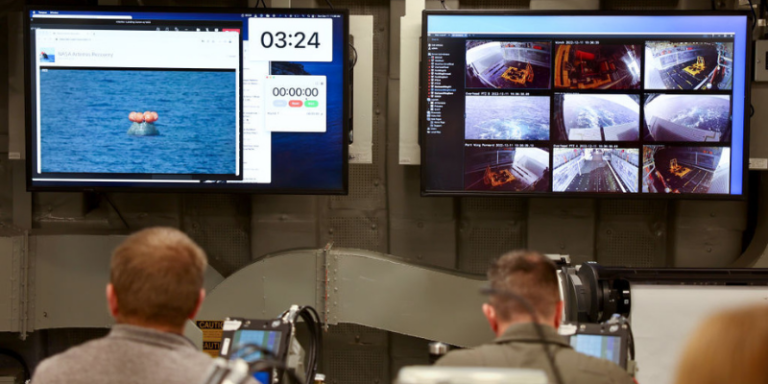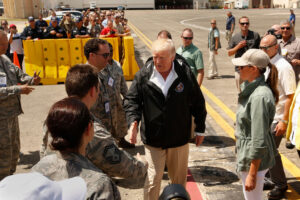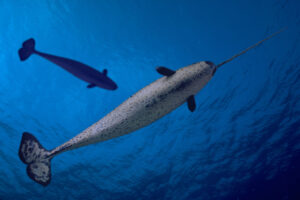The Spill: Artemis Accords
Weekly news you can use.
By: GenZ Staff | June 3, 2020 | 1100 Words

Orion Capsule NASA (Pool photo by Mario TamaGetty Images)
NASA’s Artemis Accords for Cooperation in Space
The final frontier is starting to get a lot more visitors. It had been about a decade since America launched astronauts into space, but that changed on Saturday. This time, the rocket was made by civilians in the SpaceX program – marking the first time NASA partnered with a private company. With all the recent activity, it’s no wonder NASA thought it prudent to come up with some guidelines and rules for travelers. Known as the Artemis Accords, the rules are intended for government and private space companies alike, to make sure there is information sharing and transparency.
In Greek mythology, Artemis was the daughter of Zeus and the sister of Apollo. She was revered as the goddess of hunting, wild nature, and chastity, and was also a patron of young women, often called upon to protect them during childbirth. Perhaps naming the Accords after the goddess was a way to represent this newest generation of astronauts as they embark on their adventures.
 The Artemis Accords request all space partners to share scientific data with the public and to register all space objects. Transparency is important and can lead to more information from other sources. For example, registering space objects means space hobbyists can study and learn their craft and can sometimes point out things that NASA may have missed.
The Artemis Accords request all space partners to share scientific data with the public and to register all space objects. Transparency is important and can lead to more information from other sources. For example, registering space objects means space hobbyists can study and learn their craft and can sometimes point out things that NASA may have missed.
The Accords also ensure that partners will protect sites and artifacts that have “historic value.” This can include previous Moon landings which already have more than 400,000 pounds of junk or leftover materials left behind.
On May 30, SpaceX had its first launch with a human crew to the International Space Station. The Crew Dragon spacecraft was thrust into orbit by a Falcon 9 rocket and, although the first launch was postponed due to bad weather, the second attempt was a huge success.
Trump Responds to Riots Across American Cities
Protests and riots have rocked cities across the U.S. after the tragic death of George Floyd. While many of the protesters have gathered peacefully to express their anger, some groups have been causing violence, damaging property, and looting from stores. President Trump responded to the events in a live television address.
“If a city or state refuses to take the actions that are necessary to defend the life and property of their residents, then I will deploy the United States military and quickly solve the problem for them,” Trump president declared.
Trump’s plans to deal with the situation include:
- Activating all available federal resources, civilian and military.
- Recommending that state governors deploy the National Guard “in sufficient numbers” to “dominate the streets.”
- Labeling Antifa as a domestic terrorist group.
- Adding special protection for the nation’s capital.
- “Arrest, detain and prosecute” those committing acts of violence.

President Donald Trump and First Lady Melania Trump arrive Muniz Air National Guard Base (Carolyn Cole/Los Angeles Times via Getty Images)
Other presidents have called the National Guard onto America streets, but it is very unusual for active soldiers to be deployed this way. It has only been done twice – once to stop looting in Florida after 1992’s Hurricane Hugo, and the other time was during riots in 1992 after four police officers were acquitted for brutally beating a black man named Rodney King. Some states have already called in the National Guard to get things under control. We’ll have to wait and see if Trump’s plan works.
A lot of attention is going to the violence and rioting, but many Americans have been protesting peacefully. In one event, hundreds of people gathered at the site of Floyd’s death in Minneapolis, laying flowers and signs. His brother, Terrence Floyd, spoke to the audience. He called for an end to the violence, saying:
“I understand you’re upset … but if I’m not over here wildin’ out, if I’m not over here blowing up stuff, if I’m not over here messing up my community – then what are y’all doing? Nothing, because that’s not going to bring my brother back at all. So let’s do this another way. Let’s stop thinking that our voice don’t matter and vote … because it’s a lot of us and we still going to do this peacefully.”
Scientists Capture First Narwhal Sound Recordings
Are there unicorns under the sea? Sure there are, but not the white horses with sparkling horns that we think of when picturing the fantasy creatures. The artic unicorn, on the other hand, is a real-life creature – one that has kept mostly under the radar from scientific study. But now, thanks to the help of local indigenous people and current technology, scientists are finally getting some great information from these shy sea-dwellers.

(David Fleetham/VW PICS/Universal Images Group via Getty Images)
Narwhals are the “unicorns of the ocean,” and their moniker makes sense when you look at their long “horn.” Not much is known about these underwater unicorns because they are shy and avoid humans, and because they live in icy areas of the water. One of the problems of trying to track the narwhals is that they gather near glaciers where taking boats becomes treacherous. Only Inuit hunters have been able to get close to them, and luckily for scientists, the Inuit agreed to take the researchers with them while hunting whales.
With the Inuits’ help, scientists were able to put underwear microphones on the bottoms of the boats and were excited to capture the narwhals’ clicking and whistle calls for the first time. They captured the creatures’ social calls and foraging sounds from as close as 82 feet.
The scientists discovered that, despite what was previously thought, the narwhals continue to forage for food during the summer months. The sound recordings help them decode the whistles used for social calls and the clicks the mammals use as a sonar (echolocation), much like the system used by bats and dolphins to navigate and find food. As the narwhals get closer to their food, their clicks become faster. In fact, the noise grows so much that it becomes a buzz, kind of like a chainsaw, which helps them to pinpoint their prey.
For such shy creatures, they like glacial areas that are noisy. As Evgeny Podolskiy, a geophysicist at Hokkaido University in Japan, said, “There is so much cracking due to ice fracturing and bubbles melting out … it’s like a fizzy drink underwater. It seems we are dealing with animals living in one of the most noisy environments without having much trouble with that.”

















